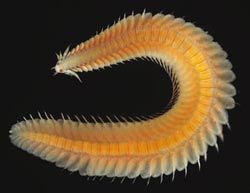Cryptic worms encountered outside Sweden

The new-found, cryptical Polychaetes Paranaitis katoi. Photographs: Arne Nygren & Fredrik Pleijel<br>
Polychaetes belong to a group of segmented worms that display enormous diversity. It turns out that there may be significantly more of these worms than researchers had imagined. Many of the worm species have been identified morphologically, that is to say on the basis of their appearance. New molecular techniques show that many worms that have been assumed to belong to the same family are not as closely related as had been thought.
Cryptic species
The research scientist Jenny Eklöf at the Department of Zoology works in the rapidly advancing field of research which studies what are known as cryptic species, that is to say animals that are identical in appearance but genetically entirely different. The focus once more is on polychaetes, where Eklöf and her colleagues show that the Scandinavian species Paranaitis wahlbergi is in fact two separate species. The researchers have named the new species, which has been encountered off Sweden, Norway and Scotland, Paranaitis katoi.
Singles species in fact two
The researchers have also found in the group of worms Notophyllum foliosum that what has been regarded as a single species is in fact two. The two species live in the same geographical area but are found at different depths: below and above the 100-metre limit. The new species is found in deep water and has been given the name Notophyllum crypticum.
Eklöf has also found a polychaete not previously encountered in European waters: Axiokebuita, a genus that usually lives in the Antarctic and also in eastern Canada.
The thesis Taxonomy and phylogeny of polychaetes was publicly defended on 21 May. Link to thesis: http://gupea.ub.gu.se/handle/2077/22179
Contact:
Jenny Eklöf, Department of Zoology, University of Gothenburg
+46 (0)31 7863661
+46 (0)763 479250
jenny.eklof@gmail.com
Media Contact
More Information:
http://gupea.ub.gu.se/handle/2077/22179All latest news from the category: Life Sciences and Chemistry
Articles and reports from the Life Sciences and chemistry area deal with applied and basic research into modern biology, chemistry and human medicine.
Valuable information can be found on a range of life sciences fields including bacteriology, biochemistry, bionics, bioinformatics, biophysics, biotechnology, genetics, geobotany, human biology, marine biology, microbiology, molecular biology, cellular biology, zoology, bioinorganic chemistry, microchemistry and environmental chemistry.
Newest articles

Properties of new materials for microchips
… can now be measured well. Reseachers of Delft University of Technology demonstrated measuring performance properties of ultrathin silicon membranes. Making ever smaller and more powerful chips requires new ultrathin…

Floating solar’s potential
… to support sustainable development by addressing climate, water, and energy goals holistically. A new study published this week in Nature Energy raises the potential for floating solar photovoltaics (FPV)…

Skyrmions move at record speeds
… a step towards the computing of the future. An international research team led by scientists from the CNRS1 has discovered that the magnetic nanobubbles2 known as skyrmions can be…





















